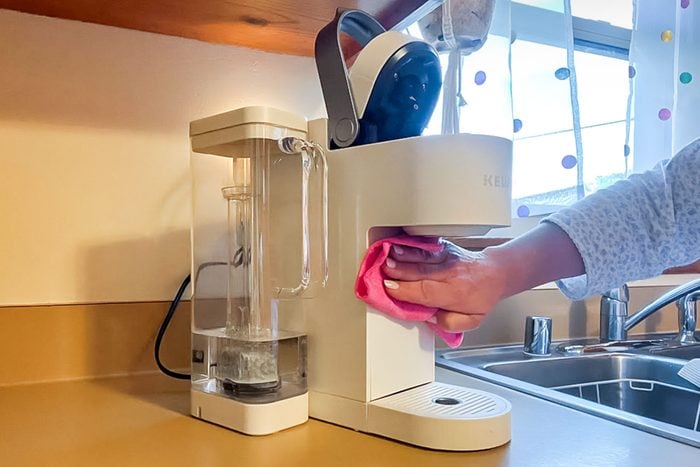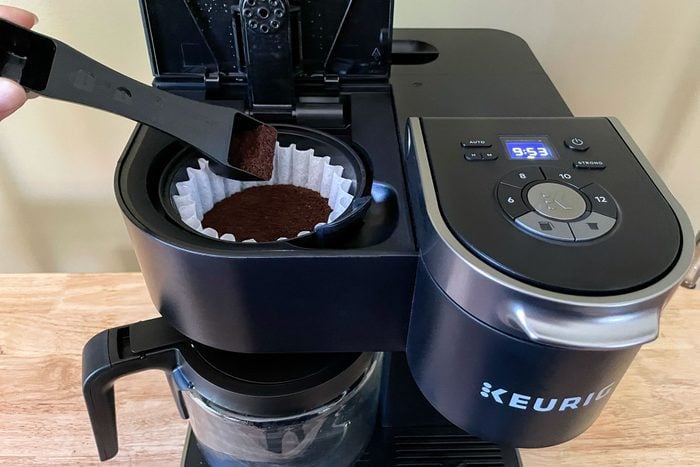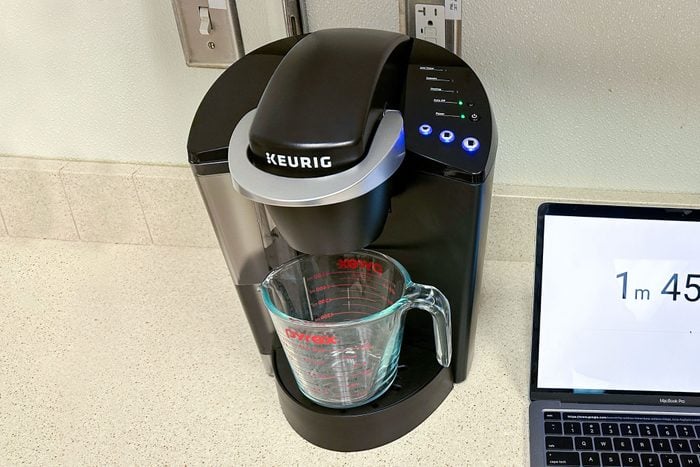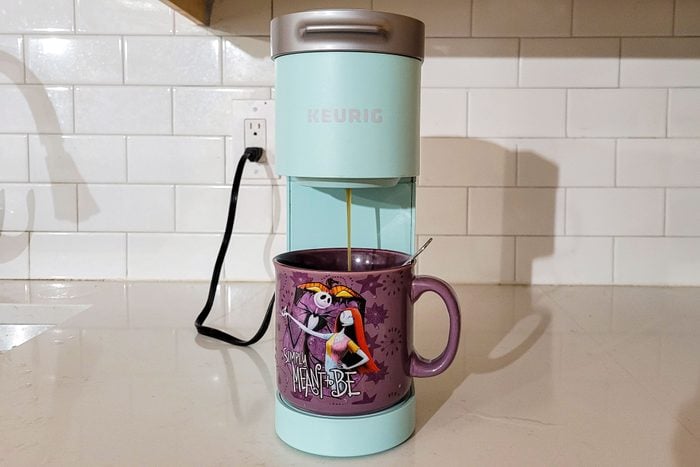CHER CHECCHIO/TASTE OF HOME
CHER CHECCHIO/TASTE OF HOME
Pros:
-
Affordable price point
-
Automatically turns off 90 seconds after your last brew to conserve energy
-
Accommodates 6- to 12-ounce drinks
-
Multiple colors available
-
Cord storage for keeping your countertops free of clutter
Cons:
-
Only brews one cup of coffee at a time
-
It lacks the programmability of other models, like temperature control or the “strong brew” option
The Keurig K-Mini Coffee Maker is the wallet-friendly answer to your coffee habit. (Set on a pricier model? Discover Keurig sales.) Slim enough to slip into any kitchen or dorm room without dominating counter space, this Keurig is a fan favorite for its affordability and size.
Cher Checchio/Taste of Home
It comes in six colors, including fun options like Dusty Rose, Evergreen and Oasis. Each K-Mini brews 6 to 12 ounces and includes an automatic feature that turns off the coffee maker 90 seconds after the last brew. Plus, a removable drip tray also accommodates a 7-inch travel mug.
The K-Mini has no fancy bells or whistles, but it doesn’t need them. It’s efficient and ensures you have coffee on demand, whenever you need it. This budget-friendly option is ideal for those who drink one cup of coffee in the morning and are good to go.
I can attest to this, as I’ve owned the Keurig K-Mini for a few years now, and it’s a total lifesaver, especially in the fall and winter. Every morning, I look forward to a single-serve brew in the comfort of my own home. All I do is add water (usually around 8 ounces), pop in a pod of my choice (I’m very into caramel macchiatos right now), press the button, and my coffee is ready in no time.
Dimensions: 11.3 x 4.5 x 12.1 inches (16.8 inches high when open) | Weight: 4.6 pounds | Capacity: 12 ounces | Wattage: 1500 watts
STACEY GENAW/TASTE OF HOME
STACEY GENAW/TASTE OF HOME
Pros:
-
Brews the largest coffee sizes: 8, 10 and 12 ounces
-
Removable drip tray accommodates 7.4-inch travel mugs
-
Customizable “strong” brew feature
-
Compatible with reusable coffee filter
Cons:
-
No temperature control or multi-stream technology
-
Water reservoir not as large as other models
Some days, you wake up, and you know you’ll need a big cup of coffee. On those days, you’ll be happy to have the Keurig K-Express Single-Serve Coffee Maker that only brews large 8, 10 or 12-ounce bold coffees that are strong enough for the morning brew or afternoon pick-me-up. Delight in the rich flavor profiles of light, medium or dark roast or any of your other favorite K-Cups. And if size really does matter, the removable drip tray on the K-Express leaves room for a 7.4-inch travel mug so you can take your fresh coffee on the go.
Stacey Genaw/Taste of Home
Unlike most other Keurig models on this list, the K-Express’s brew buttons are on the side and include the option for a “strong” brew. And there’s no need to worry about your coffee tasting lackluster or flat. Taste of Home Set Stylist Stacey Genaw says the K-Express knows how to brew a strong cup of joe. “If you like strong coffee, the beverage flavor is strong. I personally like to run another 8-ounce cup through and dilute my first cup with a second batch.”
It’s also compatible with the My K-Cup Universal Reusable Coffee Filter to brew ground coffee in an eco-friendly way.
Dimensions: 12.8 x 5.1 x 12.6 inches (17.2 inches high when open) | Weight: 4.1 pounds | Capacity: 42-ounce water reservoir | Wattage: 1000 watts
KATIE BANDURSKI/TASTE OF HOME
What to Look for When Buying a Keurig Coffee Maker
Are you on the hunt for a new Keurig coffee maker? With so many options to choose from, it’s best first to decide what type of coffee you’re interested in. Are you a fan of plain black coffee sans cream and sugar? Or do you prefer something more specialized? Keurig has a long line of coffee makers, each with its own features and functions. Consider the size of the machine relative to your kitchen counter space.
Ground your own beans? You might opt for a single-serve coffee maker with a carafe. If brew capacity is important for your family, then get a Keurig with a larger water reservoir. A single college student might be OK with the ease and simplicity of the Keurig K-Mini. Still, a seasoned coffee enthusiast would be better off with a Keurig with more programmable features like BrewID and the ability to serve hot coffee over ice. Here are some other factors (and more in-depth information) worth considering:
Model Type
Several Keurig models are available, but they typically fall into two classes: basic and advanced. Basic models are your average K-Cup brewers—designed to do little more than make a cup of coffee. Advanced models might have more features, like steaming capabilities and additional accessories. There are even some Keurigs that function both as standard drip coffee makers and K-Cup brewers. It’s important to decide whether you need something with more barebones or if you want all the bells and whistles before you shop.
Pod Variety and Availability
- K-Cup Compatibility: If you use a Keurig coffee maker, make sure you buy K-Cups that are specifically Keurig-compatible. Otherwise, they won’t fit in your machine and will be entirely useless.
- Reusable Pods: Reusable K-Cup pods allow you to put your coffee into your Keurig (rather than buying premade ones from the store). This can increase your Keurig’s versatility, cost-friendliness and environmental friendliness.
Brew Sizes
Typically, a Keurig allows users to choose between five different brew sizes: 4 ounces, 6 ounces, 8 ounces, 10 ounces and 12 ounces—the more options, the more versatile the Keurig.
Water Reservoir Capacity
Keurig reservoirs range from 40 to 80 ounces and cannot be increased in size. The size of the reservoir determines how many cups of coffee you can make before refilling it.
User Interface
Most Keurigs have fairly similar displays and controls—usually a series of buttons to control the different brewing options (and the buttons may illuminate to show whether they’re currently active or what’s selected). Some may also include a digital clock interface.
Footprint and Design
Like other styles of coffee makers, Keurigs are daily-use devices, so you’ll probably want a dedicated spot on your kitchen counter for them. Remember that some are a good deal bigger than others (especially those with a greater array of features). We would not recommend moving your Keurig between uses, as they can be quite cumbersome (especially when the reservoir is full).
Energy Efficiency
Some Keurigs need to be shut off manually (or unplugged) to cut off the power. Most, however, have an auto-shutdown feature that will automatically turn the machine off after two hours of idling (meaning without use). This feature can be turned off, as well.
Maintenance and Cleaning
- Ease of Cleaning: Keurigs are relatively easy to clean—or at least they’re not any more difficult than a standard coffee maker. Wiping them down between uses and cleaning up any lingering spills, splashes, etc., should be all you need. You may also want to do a deeper cleaning occasionally to ensure your Keurig stays in good working order. Additional features like foaming wands may require more comprehensive cleaning, as dairy buildup can promote bacterial growth.
- Descaling Alerts: Some Keurigs have a descaling alert, meaning the machine will tell you when it is time for a deep cleaning (to remove the mineral buildup caused by the water in the reservoir). It’s important to heed these warnings and complete the required descaling when the alert goes off, as it could render your Keurig inoperable if you don’t.
Additional Features
- Milk Frother: If you’re a fan of lattes and cappuccinos, prioritize getting a Keurig with an additional frothing wand. This allows you to foam milk for these specialty drinks. Ensure you’re also ready and willing to clean this feature often, as the dairy in milk can gunk them up pretty badly.
- Water Filter: Models including the Keurig Duo, Keurig Duo Plus, K-Supreme, K-Slim, K-Cafe, K-Elite, K-Select, K-Classic, K-Express and K145 support the use of compatible water filters. Some smaller Keurigs do not. This is not necessarily an essential feature, as you can filter your own water separately, but it can be a handy addition for those who want to skip an extra step.
Price and Warranty
- Cost: Compared to traditional drip coffee makers, Keurigs can seem quite expensive. They range from around $50 to over $1000 (for a commercial model). It’s important to set your budget before you shop, but remember that the more expensive, the more bells and whistles there will be. Higher-priced models might also seem more convenient overall, but they could have added maintenance costs.
- Warranty: Pay close attention to the brand’s warranty information. This allows you to discern the kinds of damage that may be covered by the warranty, allowing you to get replacement parts or an entirely replaced machine.
Why You Should Trust Us
Our nine testers have a combined decades of experience working in professional kitchens and reviewing products. We sought the expertise of the Taste of Home test kitchen leader, culinary assistants and home and kitchen product reviewers with backgrounds in cooking, recipe development, and food styling. Plus, we’re all avid coffee drinkers.
Cher Checchio, the author of this piece, is a senior shopping editor for Reader’s Digest, Taste of Home and Family Handyman. With over 15 years of experience, Cher has covered everything from foodie favorites to kitchen gadgets for print magazines, newspapers and online publications. She also has a bachelor of science degree in journalism from the University of Florida and was a lifestyle blogger for 10 years. She is uniquely qualified to speak on the subject of kitchen appliances, including Keurig coffee makers.
Sean Tirman, Content Updates Editor at Taste of Home, updated and contributed research to this piece. Sean has written shopping guides since 2016 and is a former associate editor at Gear Patrol.
How We Found the Best Keurig Coffee Makers
Sorting through the various Keurig models and identifying their similarities and differences can be dizzying, so we did it for you! For this comprehensive guide to the best Keurig coffee makers, we took into account online reviews, our own staffers’ experiences and rigorous firsthand testing.
We looked at packaging and delivery and any steps required before use. Then, we graded each Keurig coffee maker based on how loud, hot and well it brewed. Each tester evaluated their machine on size, craftsmanship, aesthetics and longevity.
Furthermore, we looked at features and functions and how they’d best serve different types of customers at various price points. Our experts gave the models that made this list the highest ratings for overall functionality and the ability to serve a delicious cup of coffee.
After six months, we also checked in with our testers to see if the machines were starting to show signs of wear, identify any issues and evaluate long-term performance.
KATIE BANDURSKI/TASTE OF HOME
FAQ
How do you clean and descale a Keurig?
You need to clean your Keurig often. Luckily, it’s simple. Cleaning a Keurig keeps mold and bacteria at bay and improves the taste of your coffee by preventing mineral build-up.
There are various ways to clean your Keurig, including Keurig cleaning pods and the Keurig descaling solution. You can also clean it with vinegar by filling the reservoir halfway with white distilled vinegar and then filling it with water. Run brew cycles until the entire reservoir is empty. Just remember to rinse it out with plain water afterward so your coffee doesn’t have that vinegar tang!
Aim to descale your Keurig every three to six months, depending on how often you use it. If you’re a daily user, you’ll want to clean the exterior, water reservoir, drip tray and pod holder once a week. This regular maintenance will help extend your Keurig’s life.
Can you make espresso in a Keurig?
You can’t make espresso in a Keurig because pulling espresso requires a large amount of pressure to force the water through the coffee grounds. But depending on what type of Keurig you own, you can customize the strength of your coffee for espresso-style drinks. If you’re looking for an espresso maker, we highly recommend the Breville Bambino Plus.
How long do Keurigs last?
Keurig machines generally last between three and five years, depending on how often you use them. You’ll know it’s time to replace the coffee maker when your coffee comes out cooler than usual, tastes watery or requires a longer time to brew.
Which model of Keurig is best?
This is highly subjective and will depend on numerous factors, including your personal needs, budget, space, etc. Our extensive testing and reviewing determined that the Keurig K-Elite Single-Serve Coffee Maker was our favorite overall.
What is the newest Keurig in 2024?
Keurig’s K-Brew + Chill Coffee Maker, which can make fresh iced coffee, appears to be the brand’s newest model at this point in 2024.
How long do most Keurigs last?
Users report that most Keurigs last three to five years. However, with proper care and maintenance, your Keurig can last far longer.


















